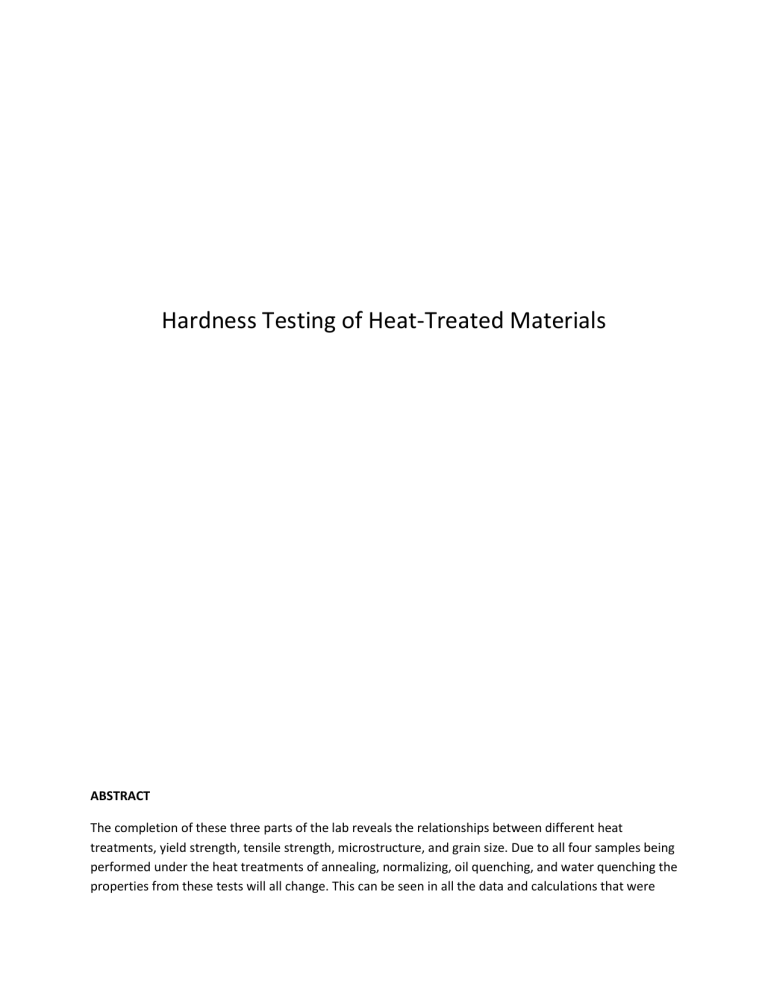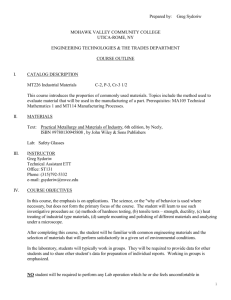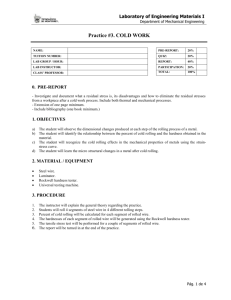
Hardness Testing of Heat-Treated Materials ABSTRACT The completion of these three parts of the lab reveals the relationships between different heat treatments, yield strength, tensile strength, microstructure, and grain size. Due to all four samples being performed under the heat treatments of annealing, normalizing, oil quenching, and water quenching the properties from these tests will all change. This can be seen in all the data and calculations that were recorded. The microstructure and grain sizes can be seen in figures 3, 4, 5, and 6. From these figures the yield strength was calculated for each heat treatment with the starting stress (𝜎𝑂 )equaling 70 MPa and the strengthening coefficient (kY) being 0.74. Comparing the results, as grain size increases yield strength decreases. The tensile strength was calculated after conducting a Rockwell Hardness Test which measured the material resistance to plastic deformation for each sample. With the help of the Brinell conversion table the tensile strength (TS) could then be calculated. It was calculated that the TS for annealing was 585.22 MPa, normalizing was 552.45 MPa, oil quenching was 690.32 MPa, and water quenching was 1,124.54 MPa. Based off these calculations something must be wrong from the annealing and the normalizing heat treatments because the tensile strength should increase as the cooling rate increases. This error could be because of the annealing process being too fast etc. INTRODUCTION To complete the following lab, four 1045 Steel samples experienced heat treatments that included annealing, normalizing, oil quenching, and water quenching. Annealing is the process of a heated metal cooling slowly which allows transformation withing the material to obtain a high ductility and low hardness. Normalizing is the process of a heated material cooling in the air to room temperature. This heat treatment allows the material to cool at a faster rate allowing the sample to produce a satisfying hardness and ductility. Quenching is the process of a heated metal that is cooled quickly within a liquid solution. The two solutions used for this lab were oil and water. Due to the fast-cooling rate of quenching, this creates the material to be harder and have less ductility. As far as determining between the two solutions on which one is harder it can be predicted by the specific heat of water vs oil. With Water having the higher specific heat, this allows the material that is submerged into it to be harder since the cooling rate will be faster. When comparing results, it should be noticed that the faster the cooling rate the higher the hardness and the lower ductility. By performing these heat treatments to the 1045 Steel samples it changes the energy within the material to create desired microstructures that produces predetermined properties (physical, mechanical, magnetic, or electrical). Using the same samples from the heat treatment, etching can be executed to determine grain size within the metallography (physical structure) of the sample. Etching is the process of polishing the surface of the material with sandpaper. Then a solution containing 95% methanol and 5% nitric acid is applied that cuts into the surface of the material to enhance the grains. A microscope can be used to see these grain structures which is shown in figures 3, 4, 5, and 6. A lineal-intercept method is utilized to determine the average grain size within each sample. (1) 𝑙𝑖 = (2) 𝑙 = 𝐿 𝑁𝑖 𝑙1 + 𝑙2 + 𝑙3 + 𝑙4 + 𝑙5 5 3 (3) 𝐷 = 𝑙 2 There are a set of equations that are utilized in determining the average grain size. Equation (1) is used to form a ratio (li) between the length of a line (L) to number of grain boundaries that line goes through (Ni). Equation (2) is used to calculate an average (l) of those five ratios. Equation three is used to determine the average grain size (D). (4) 𝜎𝑌 = 𝜎𝑂 + 𝑘𝑌 √𝐷 Once the average grain size is found, then equation (4) can be used to find the yield strength of the material (𝜎𝑌 ), but before this can be calculated the starting stress (𝜎𝑂 ) and strengthening coefficient (kY) need to be researched for 1045 Steel. When researched the starting stress becomes 70 MPa and the strengthen coefficient ends up being 0.74 [1]. When comparing these calculations of the different heat treatments it is expected to see as grain size increases then yield strength decreases. The final step in completing this lab was the Rockwell Hardness Testing of the four Steel samples. The reason for conducting the hardness test is to measure the material resistance to plastic deformation. This is determined by the Rockwell Hardness Test. Which consists of measuring the penetration dept of an indenter under a large load then comparing that to the penetration made by a preload. Note that the indenter material always should be harder than the material being tested. To find out which indenter should be used the Rockwell scale and indenters chart should mention which indenter works best for specified material. (5) 𝑦 − 𝑦1 𝑦1 − 𝑦2 = 𝑥 − 𝑥1 𝑥1 − 𝑥2 (6) 𝑇𝑆(𝑀𝑃𝑎) = 3.45 × 𝐻𝐵 From the hardness test the tensile strength can be calculated using the following equations. Each sample has six readings from the Rockwell Hardness tester, where the average is calculated. Using this information equation (5) can be used to find the Brinell hardness (HB) based off the Brinell conversion chart. Equation (6) than can be used to calculate the tensile strength (TS). After comparing the tensile strengths between the different heat treatments, it is expected to see that as the cooling rate increases so does the tensile strength. PROCEDURE In part 1 of the experiment the materials needed are 4 samples of 1045 Steel, 2 furnaces, water and motor oil. The experiment began by placing the 4 samples of 1045 Steel in a furnace of 850℃ for a minimum of 30 minutes. The first sample was moved from the 850℃ furnace to another furnace set at 400℃ and then finally the sample was placed outside of the furnace and it was brought to room temperature. The second sample was taken out of the 850℃ furnace and was placed directly in room temperature air to cool. The last 2 samples were moved from the furnace and submerged directly into water and oil. One sample of Steel was placed in motor oil to cool and the last sample was placed into water to cool. In part 2 of the experiment, in preparation for viewing the grain boundaries, the materials needed were 4 Steel samples of various preparation methods, 60 grit sandpaper, 180 grit sandpaper, 240 grit sandpaper, 600 grit sandpaper, 800 grit sandpaper, 1200 grit sandpaper, a polishing wheel, methanol, 5% nitric acid and distilled water. First, each of the 4 samples were sanded on 60 grit sandpaper in only one direction consistently for 3 minutes. The samples were then rotated 90° and sanded on 180 grit sandpaper again in one direction. The same steps were repeated again with 240 grit sandpaper. The samples were all then transferred to a polishing wheel with 600 grit sandpaper. The wheel was turned on and the samples were each held firmly against the wheel for 2 minutes. These steps were repeated again with 800, and 1200 grit sandpaper on the polishing wheel until the surface of the samples were free of visible scratches. The samples were finally moved to the etching process. An acidic solution of methanol and 5% nitric acid was etched using a q-tip for 30 seconds per sample, before being rinsed with distilled water and blown dry. Finally, the ASTM E112 test method was used to determine the average grain size and phase of the samples [2]. In the final part of the experiment, the Rockwell Hardness test, the materials needed were the 4 Steel 1045 sanded samples of various preparation methods, a Rockwell Hardness Tester, a Rockwell B scale 1/16-inch indenter and contact ball, and a Rockwell C scale diamond cone indenter. The ASTM E18 standard test method was used in this lab [3]. To begin the 1/16inch indenter was loaded into the Rockwell hardness tester which was turned on. The reset button on the machine was then pressed and the annealed treated sample was raised to the indenter until the measurement of 290, the base load, for the depth of penetration was read. The start button was then pressed leading to the major load of 100kg on the sample until a value was obtained. The sample was then released and reset so that the indenter was above a new part of sample that hasn't been damaged previously by the test. The same steps were then repeated 5 more times until there were 6 test results on one sample. Next, the normalize treated sample replaced the annealed treated sample on the tester and the same steps were repeated with this sample until 6 tests were conducted on this sample as well. The final sample tested with the 1-16inch indenter using the Rockwell B scale was the oil quench treated sample. The Rockwell C scale diamond cone indenter was then inserted into the tester. Finally, the water quench treated sample was loaded onto the Rockwell Hardness tester and the same steps were repeated once more until there were 6 test results from this sample. The test results were all recorded to be used for calculations. RESULTS & DISCUSSION While completing the heat treatment methods there were many visual and sound observations. When the third 1045 Steel sample went through the process of quenching in oil, the oil began to bubble, and smoke proceeded to come out of the beaker. When taken out of the beaker, the sample had a darker color than the rest. The fourth sample caused a sizzling sound and the water in the beaker bubbled when it when through the quenching process. As this occurred, the outer layer of the steel sample fell off because the material cooled down so fast. Given that the specific heat of water is higher than most oils, this proved that water quenching is faster than oil quenching. After the etching process each sample was observed and can be seen in Figures 3, 4, 5, and 6. The lines given were used to count the number of grains to calculate the yield strength. In Figure 3 and 4 it is difficult to see the grains as clearly as Figures 5 and 6. The grains got smaller going from the annealing process to water quenching. The data from the images were used to complete Figure 7, which is the calculation of yield strength for each sample. The last process which is the Rockwell Hardness Test, was observed and the data was configured into Table 1. The Brinell and Rockwell Conversion Chart was used for conversions [4]. During this test there was tiny shards of the samples that came off. Table 1 Rockwell Hardness Test Results 1 2 3 4 5 6 Average Brinell Tensile Strength (MPa) Annealed (kg) 85.3 86.6 87.3 87.8 86.4 87.3 86.78 169.63 585.22 Normalizing (kg) 82 86.1 85.2 84.4 83.8 84.8 84.38 160.13 552.45 Oil Quenched (kg) 90.5 94.5 94.4 92.8 94.3 94 93.42 200.11 690.32 Water Quenched (kg) 32.7 33.5 36 33 33.2 40.9 34.88 325.95 1124.54 Annealing is a slower cooling process that is used to make a material more ductile and low hardness by giving enough time to grow the grain size, which is what occurred with the first 1045 Steel sample. Normalizing creates slightly more hardness while keeping a good ductility by having a faster cooling rate than annealing. The faster cooling rate allows for the grain structure to refine and to reduce the segregation in casting. This concludes that the second sample will have a higher hardness compared to the first sample but a lower ductility. Quenching is the fastest process to cool a material out of all the processes tested in this lab. The yield strength for annealing was 70.175 MPa and for each treatment it slightly increased to 70.392 MPa for water quenching. Regarding tensile strength, it also increased from 585.22 MPa at annealing to 1124.54 MPa at water quenching. This concluded that the fourth sample had the lowest ductility and the highest hardness since it had the fastest cooling rate. The third sample had the second highest hardness. Annealing had the largest grain size and water quenching had the smallest. Also, this proves that the smaller the grain size leads to a stronger material overall. Pearlite occurred in analyzing and normalizing with more visible dark and light phases for BCC structures. Martensite consists of Austenite and long needle shaped grains that are distorted BCC structures since they did not have enough time to fully convert. Therefore, both the oil and water quenching are in Martensite phase. One possible error occurred when sanding the samples. The clearness of each surface depended on how well pressure could be applied evenly. Another issue occurred with etching given that the samples needed to continue the etching process to get clearer grains, and this led to the images of the samples being hazy. Therefore, it was hard to tell the number of grains along the lines. Lastly, an error could have occurred during the Rockwell Hardness Test since each sample was eyed up to a spot that looked relatively close to the edge and some shards often disrupted the data as well. CONCLUSION Annealing had the slowest cooling rate which led to the largest grain size and the smallest strength. On the other hand, water quenching had the fastest cooling rate and the smallest grain sizes with the largest strength. This concluded that a heat treatment with a faster cooling rate creates a stronger material, but that material then becomes less ductile. A slower heat treatment is used to create more ductile materials. It was also concluded that a smaller grain size corresponded with a higher strength, but it also led to more accurate results when counting grain size since the grains were easier to see. Overall, this lab explored the relationships between four types of heat treatments and how they alter 1045 Steel. Those relationships that were shown between the different heat treatments within the data/calculations were yield strength, tensile strength, microstructure, and grain size. The comparison between the tensile strength alone can show how the different heat treatments affect the 1045 Steel. This is shown by annealing having a tensile strength of 585.22 MPa, normalizing with a 552.45 MPa TS, oil quenching having a 690.32 MPa TS, and water quenching ending with a 1,124.54 MPa tensile strength. Based off these calculations it can also be recognized that something happened during the annealing process due to the tensile stress being more than the normalizing process. This is something to keep in mind when looking at all the data, the different kinds of errors that have occurred. WORKS CITED [1] “Grain boundary strengthening,” Wikipedia, 26-Apr-2021. [2] ASTM E112-13, Standard Test Methods for Determining Average Grain Size, ASTM International, West Conshohocken, PA, 2013, www.astm.org. [3] ASTM E18, Standard Test Methods for Rockwell Hardness of Metallic Materials, ASTM International, West Conshohocken, PA, 2020, www.astm.org [4] Engineers Edge, LLC. “Brinell and Rockwell Hardness Conversion Chart: Rockwell, Rockwell Superficial, Brinell, Vickers, Shore Hardness Conversion Table: Engineers Edge.” Engineers Edge - Engineering and Manufacturing Solutions, https://www.engineersedge.com/hardness_conversion.htm. APPENDIX Figure 3 Annealed Sample Grain Boundaries Figure 4 Normalized Sample Grain Boundaries Figure 5 Oil Quenched Sample Grain Boundaries Figure 6 Water Quenched Sample Grain Boundaries Figure 7 Calculations to find Yield Strength



